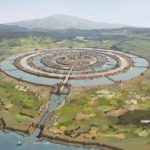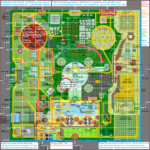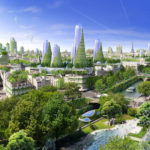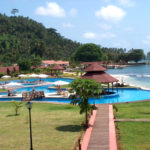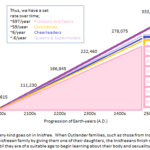This familiar-sounding term is applied in our realm to determine ideal populations and spacing for allied communities –and even worlds. (Yes, we can reposition planets and more now.)
–
Table of Contents:
- Types
- Specifics
- Multiplication-table for Humans and Human-like People vs. Acreage
- Multiplication-table for Shipping-container Farms vs. Humans/Neighborhoods
- Multiplication-table for Cities/Colonies vs. Square-miles
- Multiplication-table for Humans and Human-like People vs. Worlds
- Noting the Error in Thinking that Endless Multiplying is Holy, Desirable, or Sustainable
- Why Inisfree Permits Two Billion Human-sized Residents/Guests in One 10×10 Square-mile City
–
Types:
The ones we are talking about here are those which we use to determine:
- how many human-sized beings with human-sized appetites can sustainably live in a given area with a certain amount of confirmed resources
- how different forms and rates of reproduction eventually result in either degradation of generations/genes (sometimes known as “a generational curse”) or upgrades to generations/genes
- how big a community/city must be in order to sustainably accommodate different numbers of residents and guests (or refugees)
- how many communities/cities can sustainably coexist/fit on a world with certain dimensions (such as habitable outer-surface area; land above sea-level, for example, etc.)
They all stem from the multiplication table taught in elementary school; the chart or grid, like a table of rows and columns, showing which pairs of numbers, when multiplied together, result in which numerical outcomes.
By applying the principles of the following multiplication tables, we become able to properly and ideally space out our people, homes, and cities –and even, eventually, our worlds, solar systems, and dimensions. This prevents urban sprawl, congestion, pollution, stress, sickness, and even death. It also prevents the strain on any environment/ecosystem/biome, as well as any pollution or the depletion of resources. Using our multiplication tables in this way results in the dispersion felt to be ideal by the people in each situation where such tables/principles are understood and applied.
You’ve probably noticed how much nicer, calmer, and more helpful people in smaller towns/communities are. That is because more of them know each other, and have to interact with each other on a daily (or otherwise regular/frequent) basis; they have more pressure to get along, and more reason to. Compare that to bigger towns and cities; the latter are where there is constant fighting, crime, murder, and legal actions taken, always bringing us back to the same conclusion –that multiplication-tables are necessary to find the right number of people, helping us to avoid all that, and allowing us to predict when, where, and to what extent… those unwanted things are likely/sure to occur.
–
Specifics:
Many communities around the world have found the following to be accurate:
- Councils with more than 7 humans typically eventually fail/end (and this is more colloquially known as “the two-pizza rule”; if your meetings require more than two large pizzas to feed everyone, your gathering/team is too big).
- 5-10 acres of arable/productive land is usually what it takes to allow a family/group of 3-4 humans to live on that land (off-grid, providing all their own food/nutrients/sustenance) indefinitely
- Towns and cities should be built at least 10 miles apart (5 miles in any/every direction, giving each a ~10×10-mile grid/space to expand out into –which happens to be the size/area of Inisfree), as most towns/cities end up growing out in all directions for a few miles, if not more, and when they end up meeting… the resulting urban sprawl leads to countless problems.
- A few hundred million humans are all an Earth-sized garden-world can sustain well, and that is providing their minds/hearts are aligned to a single/singular vision/desire.
- 1 shipping-container farm can provide micro-greens and other small food-crop plants/produce for 1-2 neighborhoods, depending on how it is operated.
- Most farmland produces ~1.4 pounds of food per square-foot, and most humans need 4 pounds of food per day; it takes ~3 square-feet of farmland (productive; not just arable/potential) to produce the food each average human needs per day, therefore ~1,042 square-feet of farmland (productive) to produce the food each average human needs per year.
From this, we can extrapolate the following:
- ~3 people on every 5-10 acres means 1 council (of 7) for every 15-30 acres, if most/all members of each piece of (5-10 acres of) land are included in those councils, or 1 council (of 7) for every 35-70 acres (if at least 1 person from each piece of land is included).
- Adding a shipping-container farm to every property (such as the standard 1/4-acre plot of land for a suburban house) results in food independence for the surrounding community/neighborhoods; while 1 shipping-container farm can help provide food for multiple neighborhoods, every time a shipping-container farm is added to a house/property/land/neighborhood, that spot then becomes able to help feed another 2+ neighborhoods.
- 1,969,000 cities can comfortably exist if evenly spread out across the outer surface of the Earth, if those cities were located out on the seas and oceans, too.
- 196,900,000 square miles = 126,016,000,000 acres; divide that by 10 and we get 12,601,600,000 families, or room on Earth’s outer surface (if it was all arable/productive, which it isn’t) for ~37,804,800,000 humans. Why are we having such trouble with the 7,800,000,000 known/recorded humans on Earth today, then? It is because some of them are causing massive damage to the planet, and bunching up in inefficient cities full of incompatible beings and processes/systems. If they corrected all their erroneous ways, the Earth could sustain nearly 5 times more of them (and more than that, if humans expanded down into the crust/caves).
- Of those 196,900,000 square miles, 57,268,900 are land above water; 36,652,096,000 acres, which could theoretically sustain 10,995,628,800 humans.
- Of those 57,268,900, 12,000,000 are considered arable with current human technology/understanding; 7,680,000,000 acres, which could theoretically sustain only 2,304,000,000 humans (which is ~3.39 times how many humans are known to the global census, as of 2020, and this partially explains why nearly 1,000,000,000 are going hungry).
- Of those 12,000,000, 38,610 are being lost per year (rendered too damaged/polluted/deforested to be arable any longer, or without rapid/great/technical intervention); 24,710,400 acres lost/ruined each year, meaning humans would have to decrease their population by 7,413,120 each year in order to continue using/ruining the arable land at their current rate (and that is exactly the number projected to be permanently wounded, crippled, or rendered mentally retarded by the 2020 vaccines program, likely indicating that at least one of the globally-mandated vaccines was carefully designed to harm/reduce/kill precisely that percentage of the current human population in 2020).
- 1,042 square-feet of farmland (productive) required to produce the food (in pounds) each average human needs per year, means 1,042 x 7,800,000,000; 8,134,285,714,285.714 square-feet, which is ~186,737,505 acres. Since the estimate is that there are still 7,680,000,000 acres of arable land, all already being utilized for farming, at the current rate of their destruction (24,710,400/year), all arable land on Earth could be destroyed by humans within 310 years (which is when my visions/predictions saw them having to abandon the Earth; in 2313 A.D.)… but that doesn’t account for the facts that 1) the human population is increasing exponentially, and 2) human destruction of arable land is increasing exponentially; humans on Earth likely have mere decades left, not centuries.
- The oceans are barely being utilized (other than by fishing most of their species toward extinction each year). Land in caves is not being utilized. Land that could be made arable is not being improved in that way. Arable land is constantly being destroyed by deforestation and other unsustainable approaches. Humans will either have to stop increasing their population (paired with either restoring the land they ruined (rendered no-longer-arable/productive) or also decreasing their population in some way, such as by sending some to other worlds for colonization), or start learning and unifying their species and nations like never before, lest they end up reaching the point where the decreasing amount of livable space on their world… is used up and destroyed by their exponentially-increasing number of species members.
- If the deserts were re-greened, the mountains farmed, cities built out on the oceans and down in caves, Antarctica thawed, everyone helped to grow their own food, everyone given a shipping-container farm, millions moved to other worlds, more and more unified in education and vision/goal/s, land-destruction reduced/ended, and current yields/harvests distributed more efficiently (~50% of all food produced on Earth by humans is wasted for various reasons, as of 2020), then the current human population could remain on Earth with ease and abundance.
Furthermore, factoring in land and water used by cattle ranches, ‘cow towns’, slaughter-houses, etc., and land no one is allowed to use/develop (even though it is arable and sometimes productive), such as parks and preserves (not to mention military and Native reservations), there is no way for more than a few billion humans to comfortably/healthily live on the Earth. There is simply too much demand on existing resources, and an increasing demand, even if humans become vastly more efficient in how they use that land and the food harvested/distributed from it. Humanity now has to change in order to sustain itself.
We can also speculate that the Georgia Guidestones’ directive/recommendation to only allow 500,000,000 humans on Earth from here on… indicates either 1) the people who decided on that number were working with different and/or additional data at the time, or 2) we are not alone on this world; there are others sharing the Earth with us, they have requested/reserved some of the arable land for themselves, and humanity can no longer put a strain on those non-human people’s resources/land. Why else set the human global population cap billions lower than it needs to be? Why else reduce and limit the income of the parasitic tax-collectors that much?
–
Multiplication-table for Humans and Human-like People vs. Acreage:
3-4 humans per 5-10 acres gives us the recommended range of, at most, ~3.33 acres needed per person… down to only 1.25 acres needed per person. Adding shipping-container farms and other higher-tech means of increasing food-production/output without straining/harming the land… can change that range. On the high end, if an entire acre is covered in one layer of shipping-container farms, that land will then have the output of 7-20 times the same area of traditional, outdoor, single-layer, mono-culture farmland; the range of humans-to-needed-acreage could change to something more like 21-80 humans per 5-10 acres.

*If only the minimum acreage is available, 1 person could live off of 7x to 20x less than 1.25 acres; cover 0.0625 to 0.1785 of an acre in 1 layer of shipping-container farms, which would result in the same output as 1.25 acres of normal farmland. If you stack the containers in 2 layers, that required footprint can be reduced by half; 0.0312 to 0.0892 of an acre. If you stack the containers in 12 layers (and they may be stackable up to 16 layers), that footprint becomes only 0.0052 to 0.0148 of an acre (226.512 sq.ft. to 644.688 sq.ft.; 15.1’ x 15.1’ to 25.4’ x 25.4’). In that case (if 1 acre of land was covered in 12 layers of shipping-container farms), ~192 people could survive off the produce from 1 acre (and that would increase even more once underground layers were added; not skyscrapers filled with shipping-container farms, but ground-scrapers built down into cave-like portions of the Earth’s crust.)
–
Multiplication-table for Shipping-container Farms vs. Humans/Neighborhoods:

*One 40’ container-farm typically produces 3,000 lbs. of sellable produce each year. (~3,000 lbs./yr. during a 5- or 6-week grow-period; 10 harvests/yr., leaving gaps for downtime/maintenance/cleaning)
- 3,000/10 = 300 lbs. per harvest (300 lbs. every 6 weeks; 50 lbs./wk.; 7.14 lbs./day
- 1 average human eats ~4 lbs./day. 7.14/4 = 1.79 people fed at that rate
- or: 3,000/365 = ~8.22 lbs. of edible produce available per day, if each harvest is preserved and the total is rationed out over a full year
–
Multiplication-table for Cities/Colonies vs. Square-miles:

*Since 1 person needs 1.25 to 3.33 acres (when not using shipping-container farms), 10,000 people need 12,500 to 33,333 acres; 19.53125 to 52.082813 square-miles, so every appropriately-sized/capped city (keeping them at ~10,000 people per city) should have at least 20 square-miles, and as many as 52 square-miles to grow/expand (in)to.
–
Multiplication-table for Humans and Human-like People vs. Worlds:
This baseline comes from Earth’s 196,900,000 square-miles of land being able to comfortably sustain ~500,000,000 humans who have different views/assumptions/abilities/ties. If everyone on an Earth-sized planet with similar aspects/conditions shared more of the same views/aspects, more of them could comfortably exist and interact on that world (or on the Earth, for that matter). The more divided/different they are, the more space they need, as that is the only thing that keeps them feeling at peace, focused on doing things how they like, while incompatible people/beings are far enough away from them to do the same without ending up in conflict/war/s.

*These numbers increase dramatically once cave-layers, the oceans, and large aircraft (or floating/hover-cities) are added to the equation; trillions of people can live on every Earth-like world at that point.
–
Noting the Error in Thinking that Endless Multiplying is Holy, Desirable, or Sustainable:
“Go forth and multiply.” was absolutely wrong; it is an evil spell that leads to endless growth, thus inevitable chaos. It is a spell of cancer; metastasis. There is no sanity or balance in or from it, evident in both the logic of that argument against it, as well as all examples in history where/when that teaching (scam) was believed in and pushed for.
We Inisfreeans instead teach the far-wiser approach of multiplying only when (or if) one feels it is a good time, and only within reason, always maintaining a balance and harmony with local nature; wildlife, resources, and fellow/similar beings. We do not go forth just because we read that an alleged god told someone to long ago, and we do not reproduce for that reason. We instead trust our observations, logic, and instincts, and that has always lead us to prosperity, success, and wealth in so many forms.
If you want a god to follow, let it be nature; your own correct observations about how you work best within the world around you. If you want a commandment, guideline, or general rule to keep you aligned with a stable purpose, let it be to focus on your own improvement rather than on the mindless copying of similar human bodies into existence. If you feel it is time for you to reproduce, let it be in a more refined, graceful, intelligent, and successful way than how the humans have been doing it (pun not intended).
–
Why Inisfree Permits Two Billion Human-sized Residents/Guests in One 10×10 Square-mile City:
There are a lot of things Inisfree does very differently than humans and human cities. You can find out more about all of them on the city’s webpages. Here are some of the reasons that billions of people can visit and live in Inisfree, even though it seems so comparable to the dimensions of any of the big human-cities:
- All homes and buildings provide all their own energy and food.
- Neighborhoods and skyscrapers are built taller, as well as deeper into hillsides and underground, using vertical space both up into the sky and down into the earth.
- 2,000,000,000 residents/guests over the course of a year = 153,846,154 each Inisfreean month; 1,538,462 spread out across each of the 100 surface square-miles, which means ~18 square-feet of room per person (an area greater than 4′ x 4′, and that doesn’t account for how many will be clustered in groups, such as raves and orgies, or how many will be stacked, such as in high-rises and other tall buildings, or how many will be out exploring Antarctica, or how many will be flying or underwater or underground, or how many will be in Inisfree’s private dimension with its own solar-system full of other worlds).
- The city’s main computer works with all ICVs (Inisfreean girls) to ensure the perfect efficient distribution of food grown across our city, meaning none is wasted, and no one goes hungry.
- We are catering to people traveling to us from all over the Universe, not just from adjacent suburbs as would be the case for a normal (human) city.
Yes, a human city the size of Inisfree (10×10 square-miles; 64,000 acres, but entirely single-layer or, at most, two-story in some places, and dozens of stories in a handful of downtown places)… would best be kept to ~19,000 residents (which is about the size of most towns around the world), provided 100% of its acres were fully/well-utilized for farming food-crops (and that is possible if all properties grow their own food, include vertical- and indoor-farming, grow on their rooftops and lawns, etc.). Inisfree is not a human city, though. Inisfree is infinitely better-built and operated, thus affording it such a higher degree of population flexibility, even with all considerations of our multiplication-tables factored in.
–
–


